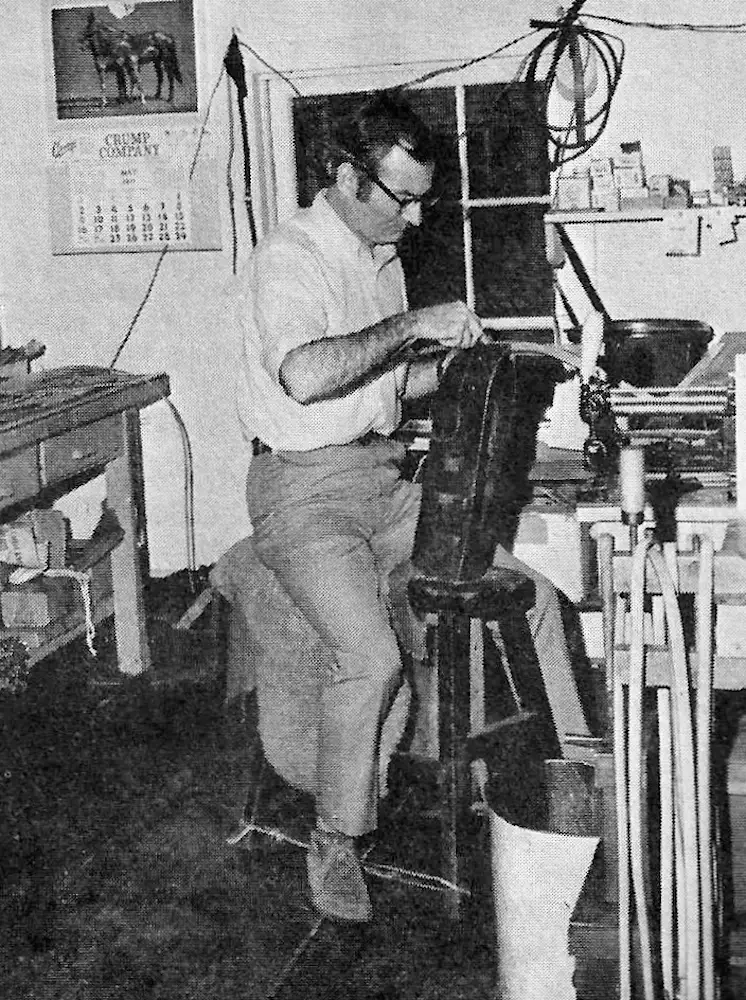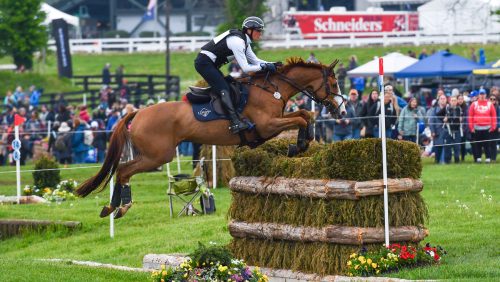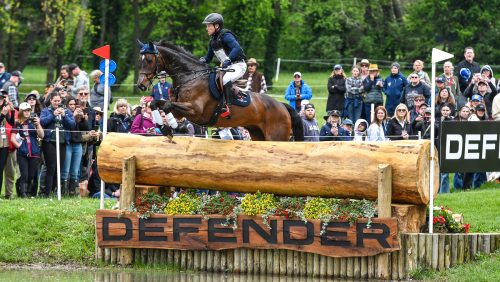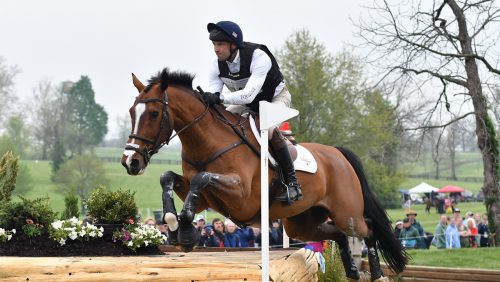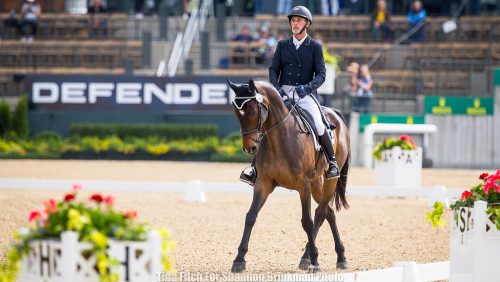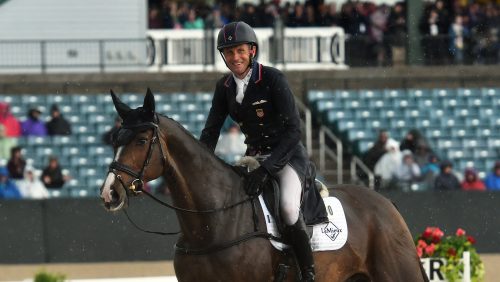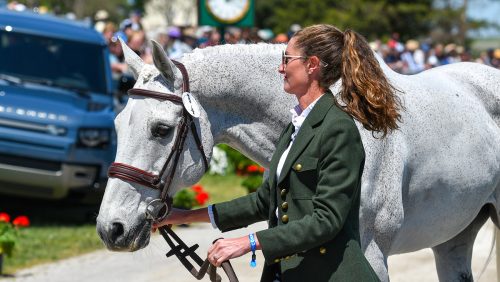My family showed at the Devon Horse Show (Pa.) for more than 30 years. For most of those years, our ponies and horses wore custom-made sewn-in bridles made by Jimmy Wiebe of Jimmy’s Saddlery. I think back on those days with fond memories.
A highlight of every Devon was getting to go visit the Jimmy’s Saddlery shop that was set up at the end of the row of stalls closest to the fair. As we drove our van or trailer into the showgrounds, through the main stable gate, we could see Jimmy’s shop directly ahead of us at the other end of the drive.
For as long as I can remember, as soon as we got our ponies and horses settled in their stalls, I’d walk the length of the drive to go visit master craftsman Jimmy Wiebe. Every year, Jimmy’s little shop was filled with beautiful new pieces of chestnut-colored tack and shiny silver bits hanging on the walls.
There was never a time when I walked into Jimmy’s Saddlery at Devon that Jimmy wasn’t working—either repairing a saddle, stitching a new bridle, or darkening someone’s new buy.
He’d stop long enough to exchange greetings and show me his new innovations in training aids or new bits, then leave me to roam the little store while he got back to work. There was always plenty of new tack to look at and drool over. It was all beautiful and made with the finest leather, hardware and stitching.
“I recall seeing him make rolled bridles when they were in fashion, and later when I apprenticed with him, I watched him make his famous half-round fancy stitched bridles,” said Wiebe’s son, Jim. “All of the work that went into those bridles was astounding. Edges rubbed by hand. Stitching sewn by hand. Many made custom for specific horses. And, for horsemen like Rodney Jenkins, Kenny Wheeler, Dave Wright’s M.J. Knoud in NYC, and many others.
“They came to Jimmy Wiebe for the very best. Dad never skimped on quality, never cut corners to shave off cost. His Jimmy’s 20th Century bridles were second to none,” Jim continued. “He also was the most knowledgeable ‘horseman saddler’ there was. He trained and showed hunters and jumpers. When he set up at horse shows, he had a full wall of bits and could explain what the different bits were for. He had a range of training aids he designed working with professionals like Tim Grubb, Jimmy Williams and others.
“My dad dedicated a lifetime to his trade. He is a self taught master craftsman second to none in his commitment to quality and to a never-ending search for more knowledge,” said Jim.
Jimmy Wiebe grew up in New Jersey to a family of craftsmen. At the age of 12, he joined the Junior Essex Troop, in West Orange, N.J., a junior cavalry organization organized to promote the cavalry style of riding and military discipline for boys between the ages of 11 and 18. The troop had been established after World War II by officers of the 102nd Armored Cavalry. For the next six years, Jimmy learned to ride and care for horses at Junior Essex Troop.
Jimmy served for three years in the Army (Maintenance Division) from 1953 to 1956. It was there that he got his start stitching. When he got out of the Army, Jimmy started stitching full-time. “The Stitcher” became his nickname. It is still used 60 years later.
It was also in 1956 that Show Jumping Hall Of Fame member Adolph Mogavero returned from Mexico where he had seen people riding jumpers in cowboy chaps. He wanted Jimmy to make some chaps suitable for hunter/jumper riders to wear while schooling horses.
Jimmy found a tannery near his shop that tanned hides for car upholstery. Unlike leather luggage or jackets, the sort of leather used in car interiors has to be durable enough to resist years’ worth of stains, fading and use caused by people sliding across it.
This upholstery leather was perfect for the chaps that Jimmy was to make. He picked a beautiful light tan colored hide that was thin enough for the rider to feel the horse’s movements and to make adjustments with his legs through the chaps yet durable enough to last when used day after day on either one horse or many horses. Jimmy made the chaps rough-side out so not to show scratches and dirt.
Jimmy’s first pair of chaps was made for Carol Werber Del Guercio, one of the country’s best riders and wife of Eligio Del Guercio. The Del Guercios owned Fairview Farms (originally in Greenwich, Conn., and then Tryon, N.C.). They showed many great horses including National Show Hunter Hall Of Fame member Bronze Wing, three-time AHSA conformation hunter champion Golden Hill, and AHSA Jumper Horse Of The Year General plus bred the great junior hunter, Wee Ken, and many others.
The second pair of chaps that Jimmy made were for National Show Hunter Hall Of Fame member Dave Kelley.
From that time on, almost every professional, amateur, junior and pony rider in the ‘60s, ‘70s, and early ‘80s had Jimmy’s chaps made for them. Jimmy’s chaps were the absolute best, and riding in them was so much better than just the regular pants or jeans that most wore while schooling back then.
ADVERTISEMENT
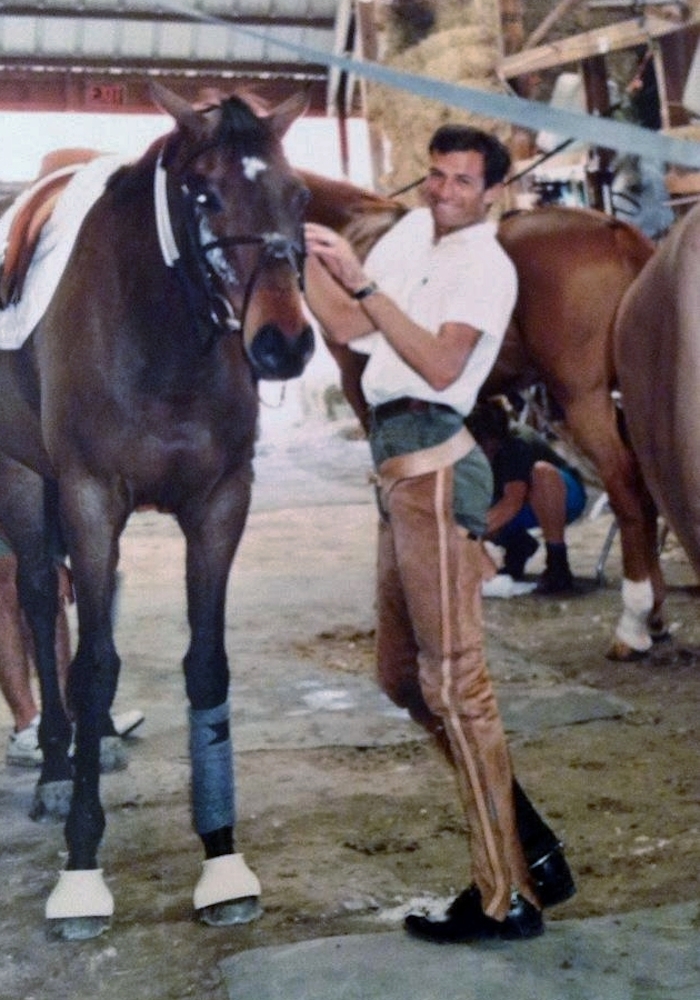
Mauro Atzeri with Kid Gloves in the aisle of the barn at Sandron wearing Jimmy’s chaps while a working student for Joe Fargis and Conrad Homfeld at Sandron in the early ’90s.
The chaps gave a rider the same feel as wearing breeches and boots. The original cost of a pair of Jimmy’s chaps was $40. The price eventually rose to $120. With the advent of chaps made of various colors with monograms and bling, the popularity of Jimmy’s chaps faded. In 1989, the tannery that Jimmy had gotten his hides from closed, and Jimmy stopped making chaps.
When Jimmy had two jumpers of his own in 1956, The Stitcher and The Stitcher’s Helper, that needed bridles, he made his first bridles. In 1958, Jimmy got Kathy Kusner to show The Stitcher at the National Horse Show at Madison Square Garden. The pair, using one of Jimmy’s bridles, won one of the open jumper classes over eventual champion, Snowman and Harry de Leyer.
In 1959, the first brick-and-mortar Jimmy’s Saddlery was opened in Oldwick, N.J., a short distance from the U.S. Equestrian Team headquarters at Gladstone. As a new horse would come to live at Gladstone (all team horses did, back then), the USET would order a custom-made halter, bridles, boots and a martingale for each of them. Jimmy always gave the USET a liberal discount.
Through Jimmy’s friendship with stable manager Bob Freels, he became friends with the coach of the show jumping team, Bert de Nemethy. De Nemethy taught Jimmy about fitting bridles properly. John Heffner, a horse dentist from Roxboro, Pa., taught Jimmy about bitting horses. It was from that tutelage that Jimmy’s well-fitting customized bridles emerged.
To order a custom bridle from Jimmy, which showed off the head of the horse or pony, measurements had to be taken, for every piece of the bridle—noseband, cheekpieces, browband, throatlatch. They were fully custom.
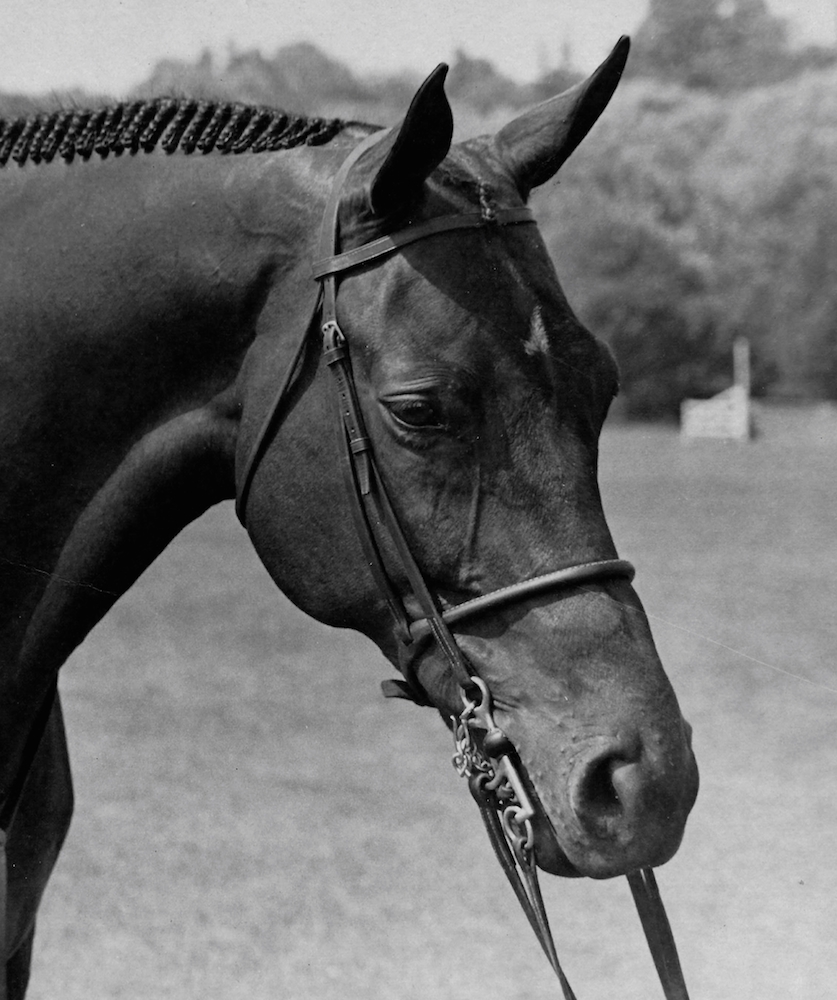
Jay Rene, owned by Junie Kulp, in his custom-made bridle made by Jimmy Wiebe. Photo courtesy of Lynn Earl McClanahan
The only remaining questions were what width cheek pieces, what width noseband, and what length rein you wanted. With all of those measurements taken correctly, Jimmy would make a beautiful bridle from the finest chestnut leather with fine stitching (14 stitches to the inch) that would fit a horse or pony perfectly. Most of the bridles through the ‘60s had the bit and the reins sewn-in. The craftsmanship in Jimmy’s bridles was second to none.
It was because of that fine craftsmanship that in 1961, Junie Kulp asked Jimmy to design a unique bridle that would show off the heads of his great stable of All Around Farm horses and ponies. Jimmy, with Junie’s help, designed the first half-round nosebands. They all had Jimmy’s signature fancy stitching in the center, which resembled the shape of a pair of glasses (or a sideways figure-eight) with a long sideways triangle coming off of each side of the glasses.
Every piece of “fancy-stitched” tack with that same pattern that you see today is because of that meeting between Junie Kulp and Jimmy Wiebe.
As a horse or pony arrived at All Around Farm to begin training with Junie Kulp, they were fitted for a sewn-in full cheek snaffle for model classes and a sewn-in rubber pelham for under-saddle classes. Between the two bridles, one was usually just right for the jumping classes.
When Junie was given the hunter Jay Rene by All Around groom Patti Saunders in 1967, he turned to Jimmy to make the fine-headed Thoroughbred a special bridle. He wanted to show off the beautiful head of his own personal horse in a bridle that was different from the other bridles used at All Around. Jimmy made Jay Rene a bridle that was flat except across the nose, where it was fully rounded.
Jimmy would darken your new tack for you or would teach you how to darken and care for it properly. To this day, there is a page on the Jimmy’s Saddlery website with instructions on darkening with Fiebings neatsfoot oil and a new small paintbrush, conditioning with Tackmaster, and then maintaining with either Fiebings Paste Saddle Soap or Belvoir glycerine bar soap. There is still tack made by Jimmy over 50 years ago that was maintained properly and is being used today.
Jimmy was also known for his tack repair. In the early ‘60s, he purchased a truck that he filled with tack and bits to sell at shows plus his stitching horse and tack repair supplies. Besides the shop at Devon, Jimmy would take his truck to several other big shows a year—Sussex County (N.J.), Fairfield (Conn.), Ox Ridge (Conn.) and the Florida winter circuit.
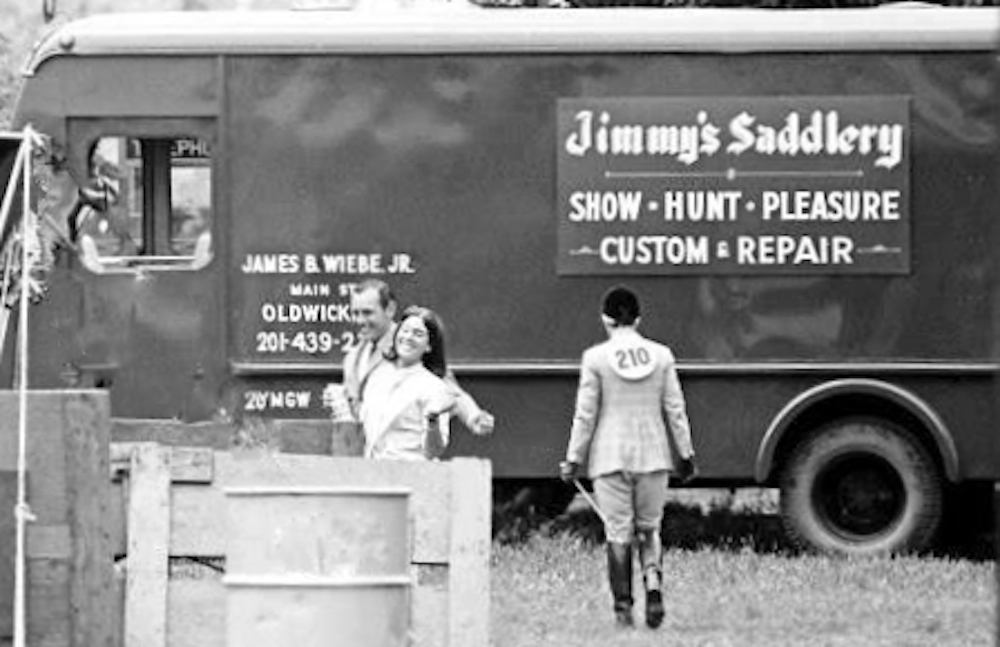
Jimmy’s Tack Truck in 1964 at Ox Ridge. Photo courtesy of Jim Wiebe
In 1964, Jimmy hired a young Lloyd Longnecker (now owner of Ryegate Show Services) to go to Florida as a helper. Lloyd tells the story:
ADVERTISEMENT
“In the late fall of 1964 I was hanging out at Joe and Peggy Green’s farm while my hand healed from an accident at the steel fabrication shop where I was working. Peggy told me of this job opening to go to Florida for the winter. I drove to New Jersey and had an interview with Jimmy, met his wife and two very young children.
“We worked out a deal. Not much pay, but I had never been anywhere like this, warm weather and all that.
“We attended three venues, each for several weeks, on the old Sunshine Circuit. Winter Haven, which had hunters and jumpers during the day and Saddlebreds at night. Then Del Ray at the Polo Club. Beautiful. Then South Miami where it was hot and dirty.
“Jimmy sold strap goods, saddles, liniments and all the other needs of all the horsemen, including an amazing collection of bits. I was constantly in awe of the famous horsemen walking into his walk-in truck that served as our mobile shop. Earl Frazier, Ennis and Rodney Jenkins, Roger Young, Dave Kelley; all those names I had read about were shaking my hand and talking to me, the young kid from Pennsylvania.
“My main job was oiling the new leather goods that were sold. I went through a lot of oil in those two months.”
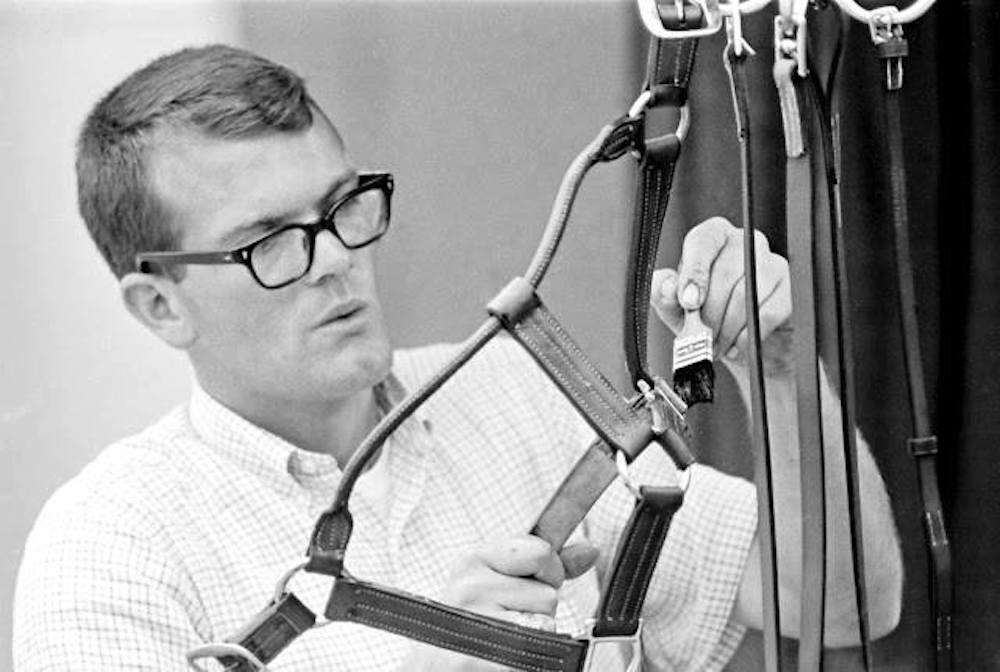
Lloyd Longnecker oiling a halter in Florida in 1964. Photo courtesy of Jim Wiebe
“I also helped with sales while Jimmy supervised from his perch on his stitching horse in the front of the truck while repairing items or making new equipment for his customers. He handmade all the bridles and was very innovative with the half-rolled parts, the fancy stitched cavessons and brow bands. Broken saddle trees were repaired daily. He was the innovator of a saddle with adjustable parts, so the saddle fit the rider and horse.
“He taught me so much about the saddlery trade. I learned the basics of stitching and what equipment and bit would work best for any situation his customer described. Working with him was the best experience a 20-year-old could imagine.
“It helped so much when I returned home and took jobs with prominent horsemen such as Eggy Mills and Raymond Burr. And later, after my enlistment in the Navy, the knowledge he gave me was invaluable when I operated a riding and show stable for several years.”
By 1966, demand was so great for tack from Jimmy’s that Jimmy started to have some of his non-custom tack made in England to the same standards as the custom tack. It was at this time that Jimmy’s first saddle was designed and made. The “20th Century” was a close-contact saddle similar to the Steinkraus Hermes except the seat was a wee bit deeper and the price was more affordable.
Ever the innovator, in 1968 Jimmy saw the need for a saddle that was designed specifically for small children on ponies. He designed and started to make the “Little Division Pony Saddle.” The saddle filled a need. Soon, it seemed that everywhere you looked at an A show, little children on their fat ponies were using Jimmy’s Little Division Saddle.

Four ads that were run in 1981 for Jimmy’s Saddlery.
Jimmy has continued to design new tack and new training equipment through all of these years.
Now located in Nevada, 83-year-old Jimmy Wiebe is still making tack with the hands of a craftsman.
Although Jimmy hasn’t had his shop at Devon since 1989, every time I have been through the stable gate over the years, I look the length of the drive and expect to see the little blue trimmed shop with the small sign that says “Jimmy’s Saddlery” beside the door. In my mind, Jimmy’s Saddlery will always be at the end of the drive as you enter the stable gate at Devon.

